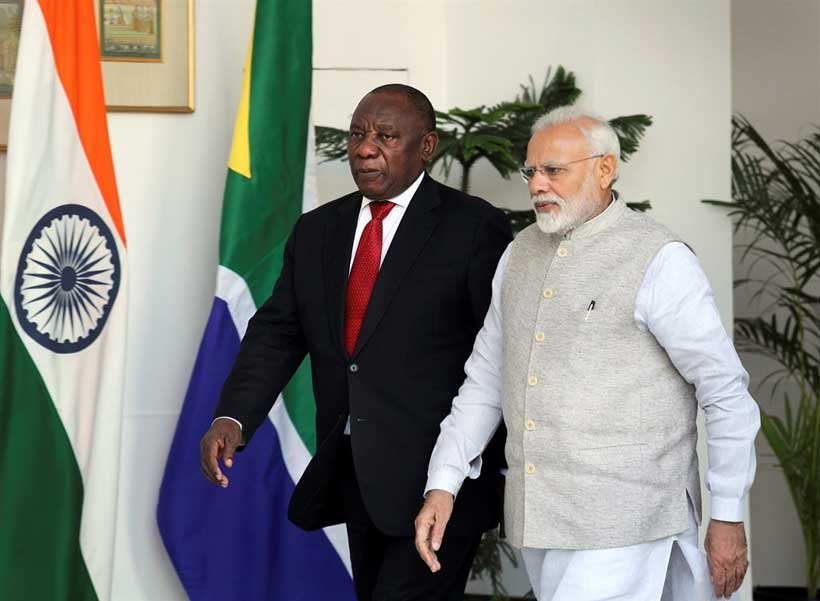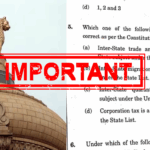India’s digital diplomacy in Africa: A new chapter in South-South cooperation
Why in the news?
On May 25, the continent celebrated Africa Day, marking the anniversary of the establishment of an organisation of African unity in 1963. This year, Africa Day gave a deep significance to Indo-African conditions when New Delhi utilised digital diplomacy to create development participation in the continent quickly. India’s support for Africa’s digital change matches the broad continental strategies of Africa, after South-South cooperation. With initiatives such as Aadhaar-based identification platforms, UPI-operated economic systems and Dixit, India appears as a strategic partner offering scalable, open-source source and inclusive digital public infrastructure (DPI) in African countries.

Background: The Rise of Africa’s Digital Ambition
- Africa is undergoing a significant digital shift. Home to 1.4 billion people, with a median age of under 20, the continent is increasingly positioning digital technology as a central lever of socio-economic development.
This transition is informed by key challenges and aspirations:
- Overcoming legacy infrastructure gaps in education, health, banking, and governance.
Leveraging the potential of the young, tech-savvy population for innovation and entrepreneurship. - Building resilient and adaptive systems that can work in low-resource settings through mobile-first, open-source, and decentralised platforms.
- Against this backdrop, Africa’s Digital Transformation Strategy for 2020–2030, endorsed by the African Union, seeks to accelerate digital access, literacy, and inclusion across sectors. The strategy is backed by continental and regional coalitions such as:
- Smart Africa Alliance: A platform of 30+ countries working to harmonise digital policies and infrastructure.
GIGA Initiative: A collaboration with the UN to connect every school to the internet.
African Continental Free Trade Area (AfCFTA): Where digital trade and e-commerce are seen as key enablers of pan-African integration.
What is Africa’s digital strategy?
The digital transformation strategy of the African Union emphasises a vision:
- Rapid socio-economic development
- E-control platform for transparent and available service distribution.
- Telemedicine and e-learning solutions to bridge the access gap.
- National Digital Identification Program for Economic Inclusion and Civil Empowerment.
- Inclusive and permanent development: To ensure that no one is left behind.
- Promote digital entrepreneurship among youth and women: To ensure that technologies comply with ownership and values in Africa, and reject the model that is required.
- Continental coordination: Adjusting national digital policies with platforms like Smart Africa.The difference between systems in activating boundary services. Collective purchases with global technical players on data management, standards and platform access. This is the place where India finds resonance – both as a digital success story and a development partner who understands the challenges in the global south.
How does India support Africa’s digital change?
India’s approach to digital cooperation with Africa lies in three main principles: strength, inclusion and partnership. Here are the most important columns:
- Digital Public Infrastructure Sharing (DPI)
- India shares open open-source, scalable platform:
- Aadhaar for digital identification,
- UPI for interoperative payment,
- Dixit for digital learning material.
Example:
- In 2024, Bank of Namibia signed an MOU with NPCI International, such as a UPI-like real-time payment system, which was based on India’s experience with Fintech inclusion
- Technical Collaboration and Capacity Building India doesn’t just export software- it partners for technical implementation and trains African professionals in deploying and managing these tools.
Example: Togo collaborated with IIIT-Bangalore to build a digital ID system using the Modular Open Source Identity Platform (MOSIP) developed in India. Academic and Institutional Support: India supports human capital development by building institutional partnerships.
Example: IIT Madras opened its first overseas campus in Zanzibar (Tanzania) in 2023. The campus offers degrees in AI and Data Science, focusing on digital skilling for African students. Tele-Education and Telemedicine Platforms: India pioneered the Pan-African e-Network (2009), providing satellite-based digital education and health consultations from top Indian institutions to 50+ African nations.
Example: Real-time medical advice from AIIMS and educational lectures from IGNOU were beamed to classrooms and clinics across Africa.
Open-Source and Inclusive Models Unlike proprietary solutions, India offers Digital Public Goods systems that are open-source, cost-effective, and customizable.
Example: Ghana integrated its financial system with UPI to enable secure, low-cost, real-time payments, without dependency on Western payment gateways. Technical cooperation and capacity building, India exports not only software, but it also serves as a partner for the technical implementation and training of African professionals.
How is India’s digital diplomacy different?
- India’s digital connection to Africa varies rapidly from global powers such as the United States and China, both in philosophy and execution.
- Digital public goods model versus professional system
- India considers its platforms as regular, not objects.
- China’s digital system is often linked with surveillance units and depends on Chinese technical companies. India’s open-source DPIs, such as Moscip, Beckan and Digilokar, are independent and adaptable, which ensures digital sovereignty for other nations.
Co -development vs. Tech dumping
India creates the solutions and creates local capacity instead of selling the Turny system.
- Example: Instead of exporting technology only, India helps to adapt platforms for local languages, political needs and infrastructure realities.
- Non-qualified engagement
India respects local priorities, unlike Western assistance that can provide political conditions or Chinese infrastructure that often leads to a debt trap.
Example: Countries such as Zambia and Ghana chose Volunteer DPI in India due to strength and alignment, not because of geopolitical pressure or debt obligations.
What Challenges Block Africa’s Digital Growth?
- Despite its ambitions, Africa faces multiple hurdles in becoming a digital-first continent:
- High Cost of Access
- Internet data remains prohibitively expensive.
- Devices like smartphones and laptops are out of reach for many.
- Example: In 2023, mobile data costs in some African countries exceeded 5% of monthly income, far above the UN-recommended threshold of 2%.
Digital Divide
- Urban areas dominate in terms of connectivity and services.
- Rural populations and women are disproportionately excluded.
- Example: Women in sub-Saharan Africa are 37% less likely than men to use mobile internet, deepening inequality.
- Inadequate Energy Infrastructure
- Digital platforms depend on stable electricity, which remains patchy.
- Example: Countries like Nigeria face regular power outages, affecting internet access and data reliability.
Lack of Local Talent
- Africa needs a digitally skilled workforce.
- Most countries face a shortage of trained engineers, cybersecurity experts, and AI developers.
Regulatory Fragmentation
- Lack of harmonised laws and standards across African nations delays cross-border digital services and trade.
Way Forward: Towards a Resilient Digital Africa
India and Africa can deepen their digital cooperation by focusing on the following areas:
Expand Affordable Access
- Invest in low-cost internet infrastructure.
- Subsidise digital devices for students, women, and rural communities.
- Encourage public-private partnerships for last-mile connectivity.
Strengthen Energy and Digital Infrastructure
- Integrate renewable energy with digital rollouts.
- Support solar-powered telecom towers and microgrids in rural regions.
Build Human Capital
- Scale up joint degree programs, online skilling courses, and digital fellowships.
- Facilitate African student mobility to Indian institutions under Scholarship programs.
Develop Local Innovation Ecosystems
- Support African startups through funding, mentoring, and access to India’s innovation networks like Startup India and Atal Innovation Mission.
- Encourage Indian tech companies to invest in Africa not as markets, but as partners in innovation.
Promote Digital Sovereignty
- Continue to offer DPI as Digital Public Goods.
Assist African countries in drafting data protection, privacy, and cybersecurity laws based on global best practices.
Conclusion
India’s digital diplomacy in Africa is not just a strategic manoeuvre, is a civilizational partnership rooted in shared development goals. By offering affordable, inclusive, and adaptable digital infrastructure, India is helping African countries craft their digital destiny. Unlike Western or Chinese models that focus on profit or power, India’s approach emphasises empowerment, equity, and empathy. On the occasion of Africa Day, it is this spirit of South-South collaboration that must guide the future of India-Africa ties, where digital bridges replace digital divides, and technology becomes the language of partnership, not patronage.
MAINS PRACTICE QUESTION
Question: Discuss the significance of India’s digital diplomacy in Africa. How is it distinct from the digital strategies of other major powers like the US and China? What challenges do African nations face in realising their digital ambitions, and how can India contribute to overcoming them? (250 words)
PRELIMS PRACTICE QUESTION
Q.1 About India’s Digital Diplomacy in Africa, consider the following statements:
- The Pan-African e-Network was launched in 2020 to provide telemedicine and tele-education support to African countries.
India’s Modular Open-Source Identification Platform (MOSIP) has been adopted by some African countries for building digital identity systems. - UPI is a proprietary, closed-source platform exported by India to African nations under bilateral conditions.
Which of the above statements is/are correct?
A. 1 and 2 only
B. 2 only
C. 1 and 3 only
D. 1, 2, and 3
Answer: B. 2 only
- Statement 1 is incorrect: Pan-African e-Network was launched in 2009, not 2020.
- Statement 2 is correct: MOSIP is being used by countries like Togo.
- Statement 3 is incorrect: UPI is an open-source digital public good, not proprietary.







